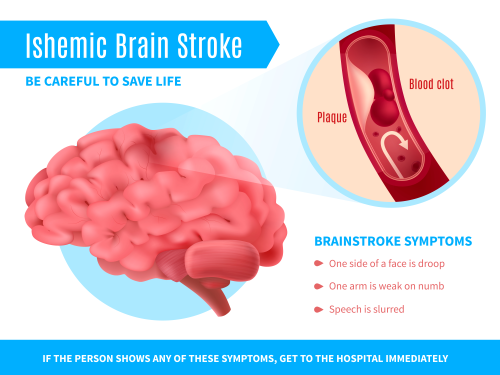Tissue Plasminogen Activator (tPA)
Tissue plasminogen activator otherwise known as tPA or alteplase, is a medication used in the treatment of ischemic stroke. It was FDA-approved in 1996 and is a drug that can dissolve blood clots. The sooner tPA is administered, the better the chance for recovery, so it is imperative to seek medical attention quickly if experiencing stroke-like symptoms. The window of opportunity for treatment is typically within the first 3 to 4.5 hours after symptoms begin. This is because the longer the brain is deprived of oxygen, the greater the likelihood of irreversible damage.
 Image by macrovector on Freepik
Image by macrovector on FreepiktPA works by promoting the breakdown of blood clots that are causing the blockage in the brain's blood vessels. It does this by converting plasminogen, a protein present in the blood, into plasmin, an enzyme that helps dissolve clots. By breaking down the clot, tPA can potentially restore blood flow to the affected area of the brain, limiting the extent of damage and improving the chances of recovery.
Tissue Plasminogen Activator (tPA) and Treatment Information
Time Window: tPA is most effective when administered as soon as possible after the onset of stroke symptoms typically within the first 3 to 4.5 hours after symptoms begin.
Patient Selection: Not all stroke patients are eligible for tPA treatment. There are strict criteria that need to be met to ensure the benefits of tPA outweigh the risks. A thorough evaluation is necessary to determine if the patient is an appropriate candidate for treatment. Tissue plasminogen activator is not indicated for treatment in hemorrhagic strokes which cause bleeding in the brain. tPA is not used in this type of stroke because it could increase the amount of bleeding and cause more damage. tPA might not be used in other situations as well such as:
recent heart attack
pregnancy
bleeding problems
head injury within the past 3 months
use of blood thinners
surgery within the past 14 days
recent blood in your urine or stools
Risks and Benefits: While tPA can be life-saving for some patients, it also carries certain risks. One of the main concerns is the potential for bleeding, including bleeding in the brain (intracerebral hemorrhage). This risk needs to be carefully considered when deciding whether to administer tPA. Other risks can include allergic reactions, hematoma formation, low blood pressure, and reperfusion injury where the sudden influx of oxygen and nutrients can trigger inflammation and cellular damage. Some side effects of tPA can include nausea, vomiting, fever, and headache. The side effects are closely monitored and treated when needed by the healthcare team.
It's important to note that the risks associated with tPA treatment are weighed against the potential benefits. tPA has been shown to significantly improve outcomes for many patients with ischemic stroke when administered within the appropriate time window and under the supervision of medical professionals.
Administration: tPA is typically administered intravenously (IV), meaning it's injected directly into a vein. The dosage and rate of administration are carefully monitored to minimize the risk of bleeding while effectively breaking down the clot.
Monitoring: After tPA administration, patients are closely monitored for changes in neurological status and any signs of bleeding. Frequent imaging, such as CT scans, may be performed to assess the patient's condition.
Other Treatments: In some cases, mechanical thrombectomy may be considered alongside or instead of tPA. This procedure involves physically removing the clot using specialized tools inserted into the blood vessels. Mechanical thrombectomy is particularly effective for large clots and can extend the treatment window beyond that of tPA alone. Tenecteplase, another clot-busting drug, has emerged as a potential alternative to alteplase, and its off-license use in acute ischemic stroke has increased in recent years.
Determining Appropriate Treatment: It's important to note that stroke treatment is a complex and time-sensitive process. If you suspect someone is experiencing a stroke, it's crucial to seek medical attention immediately by calling emergency services. Only medical professionals can accurately diagnose the type of stroke and determine the appropriate treatment options based on the patient's condition and individual factors. For more specific information on the criteria that healthcare providers use in determining if tPA is appropriate see the Guidelines for the Early Management of Patients with Acute Ischemic Stroke at https://www.stroke.org/-/media/Stroke-Files/Ischemic-Stroke-Professional-Materials/AIS-Toolkit/Guidelines-for-Mangaging-Patients-with-AIS-2019-Update-to-2018-Guidelines.pdf
Get Our Stroke Rehab Guide

Our stroke rehab guide is designed specifically for patients and caregivers. It's in pdf format and can be immediately downloaded. It includes about
- Stroke Definition & Causes
- Stroke Treatment
- Rehabilitation Information for Physical, Occupational and Speech Therapy
- Exercise pictures
- Q&A from patients and caregivers
- Adaptive Equipment & Techniques
- How to Prevent Another Stroke & More!
Medical Disclaimer: All information on this website is for informational purposes only. This website does not provide medical advice or treatment. Always seek the advice of your physician or other healthcare provider before undertaking a new healthcare or exercise regimen. Never disregard professional medical advice or delay seeking medical treatment because of something you have read on this website. See the disclaimer page for full information.
- Home
- Stroke Treatment
- Tissue Plasminogen Activator (tPA)
















